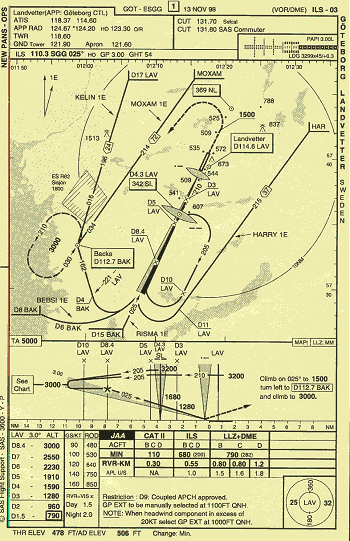10. APPROACH.As soon as we contact the approach controller, we will have to ask for a CAT II. The reason is that there are some backup equipment and special procedures on ground, when CAT II or CAT III are in use. One example; there are always two holding positions at the runway end. CAT I holding is closer to the RW than CAT II.  From BAK VOR we will probably get radar vectoring for the approach. ATC will
vector us to a final intercept angle of around 30 degree. In this case 055 degree.
As soon as we get "Scandinavian 149, turn left to heading 055, cleared for the
approach" arm the autopilot in ILS and put the flightdirector in Radio Auto.
Then the autopilot will capture the ILS localizer.
From BAK VOR we will probably get radar vectoring for the approach. ATC will
vector us to a final intercept angle of around 30 degree. In this case 055 degree.
As soon as we get "Scandinavian 149, turn left to heading 055, cleared for the
approach" arm the autopilot in ILS and put the flightdirector in Radio Auto.
Then the autopilot will capture the ILS localizer.30 degree intercept is standard, older autopilots (like the DC9) need this. In modern aircrafts, the autosystem will normally be able to intercept at an angel twice as big. In FS98, you will have to test the autopilot in every panel. The standard AP in B737 is lousy. You have to use intercept of 10 degree, otherwise, the AP will not be able to stabilize on the localizer. Remember - you need to get "cleared for the ILS 03, or cleared for the approach 03" otherwise you are only allowed to intercept and follow the ILS localizer, not the glidepath. SETTING OF NAVAIDS. Without radarvectoring. Establish on radial 162 out of BAK, at DME 4 ( radial 221 LAV) turn left to heading 055 and make you own turn on. Set BAK radial 162 on NAV 1 and LAV radial 221 on NAV 2. Besides we can use NDB SL on NDB 1 and NDB 2 as backup. As soon as we reach our turning point (DME 4), we do not need BAK any more, and can put the ILS 110.3 on NAV 1. The ILS need to be set on NAV 1, otherwise the AP will not capture the ILS. NAV 2 can not be used by the autopilot. This is the same setup on the navaids, as I use in FS98. The only exception is of course that NDB 2 is non existing. SPEED. When leaving BAK we start to reduce our speed. Reduce thrust and extend flaps 5. Let the speed drop to around 200 kt when approaching the turning point. The first thing that happens when moving the flap/slat handle is that the slats extend, then there is a detent for flaps 5, 15, 25 and 40. Flaps 50 was used earlier, but due to noise this flap setting is restricted to emergency use only. In the speedbooklet you can find the lowest speed foe every flap setting. |
| Go back toFlying the CLASSIC. | Move on toLanding. |